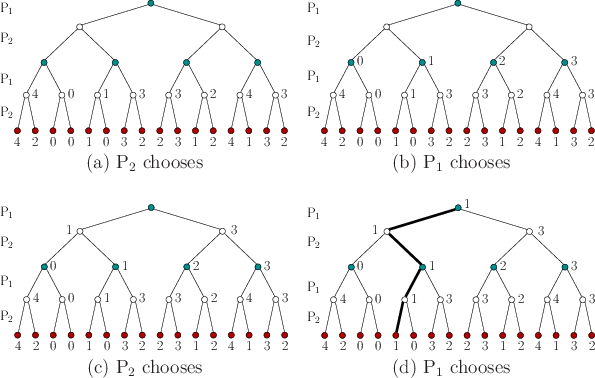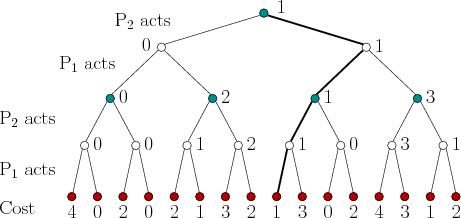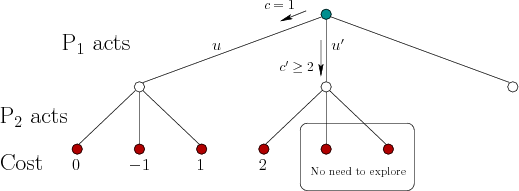
Next: 10.5.1.2 Computing a saddle Up: 10.5.1 Game Trees Previous: 10.5.1 Game Trees
The notion of a security strategy from Section 9.3.2
extends in a natural way to sequential games. This yields a
security plan in which each player performs worst-case analysis
by treating the other player as nature under nondeterministic
uncertainty. A security plan and its resulting cost can be computed
by propagating costs from the leaves up to the root. The computation
of the security plan for
![]() for the game in Figure 10.13
is shown in Figure 10.14. The actions that would be chosen
by
for the game in Figure 10.13
is shown in Figure 10.14. The actions that would be chosen
by
![]() are determined at all vertices in the second-to-last level of
the tree. Since
are determined at all vertices in the second-to-last level of
the tree. Since
![]() tries to maximize costs, the recorded costs at
each of these vertices is the maximum over the costs of its children.
At the next higher level, the actions that would be chosen by
tries to maximize costs, the recorded costs at
each of these vertices is the maximum over the costs of its children.
At the next higher level, the actions that would be chosen by
![]() are determined. At each vertex, the minimum cost among its children
is recorded. In the next level,
are determined. At each vertex, the minimum cost among its children
is recorded. In the next level,
![]() is considered, and so on, until
the root is reached. At this point, the lowest cost that
is considered, and so on, until
the root is reached. At this point, the lowest cost that
![]() could
secure is known. This yields the upper value,
could
secure is known. This yields the upper value,
![]() , for the sequential game. The security plan is
defined by providing the action that selects the lowest cost child
vertex, for each
, for the sequential game. The security plan is
defined by providing the action that selects the lowest cost child
vertex, for each
![]() . If
. If
![]() responds rationally to the
security plan of
responds rationally to the
security plan of
![]() , then the path shown in bold in Figure
10.14d will be followed. The execution of
, then the path shown in bold in Figure
10.14d will be followed. The execution of
![]() 's
security plan yields the action sequence
's
security plan yields the action sequence ![]() for
for
![]() and
and ![]() for
for
![]() . The upper value is
. The upper value is
![]() .
.
 |
 |
A security plan for
![]() can be computed similarly; however, the
order of the decisions must be swapped. This is not easy to
visualize, unless the order of the players is swapped in the tree. If
can be computed similarly; however, the
order of the decisions must be swapped. This is not easy to
visualize, unless the order of the players is swapped in the tree. If
![]() acts first, then the resulting tree is as shown in Figure
10.15. The costs on the leaves appear in different order;
however, for the same action sequences chosen by
acts first, then the resulting tree is as shown in Figure
10.15. The costs on the leaves appear in different order;
however, for the same action sequences chosen by
![]() and
and
![]() , the
costs obtained at the end of the game are the same as those in Figure
10.14. The resulting lower value for the game is found to be
, the
costs obtained at the end of the game are the same as those in Figure
10.14. The resulting lower value for the game is found to be
![]() . The resulting
security plan is defined by assigning the action to each
. The resulting
security plan is defined by assigning the action to each
![]() that maximizes the cost value of its children. If
that maximizes the cost value of its children. If
![]() responds
rationally to the security plan of
responds
rationally to the security plan of
![]() , then the actions executed
will be
, then the actions executed
will be ![]() for
for
![]() and
and ![]() for
for
![]() . Note that these are
the same as those obtained from executing the security plan of
. Note that these are
the same as those obtained from executing the security plan of
![]() ,
even though they appear different in the trees because the player
order was swapped. In many cases, however, different action sequences
will be obtained.
,
even though they appear different in the trees because the player
order was swapped. In many cases, however, different action sequences
will be obtained.
As in the case of a single-stage game,
![]() implies
that the game has a deterministic saddle point and the value of
the sequential game is
implies
that the game has a deterministic saddle point and the value of
the sequential game is
![]() . This particular
game has a unique, deterministic saddle point. This yields
predictable, identical choices for the players, even though they
perform separate, worst-case analyses.
. This particular
game has a unique, deterministic saddle point. This yields
predictable, identical choices for the players, even though they
perform separate, worst-case analyses.
A substantial reduction in the cost of computing the security
strategies can be obtained by recognizing when certain parts of the
tree do not need to be explored because they cannot yield improved
costs. This idea is referred to as alpha-beta pruning in AI
literature (see [839], pp. 186-187 for references and a
brief history). Suppose that the tree is searched in depth-first
order to determine the security strategy for
![]() . At some decision
vertex for
. At some decision
vertex for
![]() , suppose it has been determined that a cost
, suppose it has been determined that a cost ![]() would
be secured if a particular action,
would
be secured if a particular action, ![]() , is applied; however, there are
still other actions for which it is not known what costs could be
secured. Consider determining the cost that could be secured for one
of these remaining actions, denoted by
, is applied; however, there are
still other actions for which it is not known what costs could be
secured. Consider determining the cost that could be secured for one
of these remaining actions, denoted by ![]() . This requires computing
how
. This requires computing
how
![]() will maximize cost to respond to
will maximize cost to respond to ![]() . As soon as
. As soon as
![]() has
at least one option for which the cost,
has
at least one option for which the cost, ![]() , is greater than
, is greater than ![]() , the
other children of
, the
other children of
![]() do not need to be explored. Why? This is
because
do not need to be explored. Why? This is
because
![]() would never choose
would never choose ![]() if
if
![]() could respond in a way
that leads to a higher cost than what
could respond in a way
that leads to a higher cost than what
![]() can already secure by
choosing
can already secure by
choosing ![]() . Figure 10.16 shows a simple example. This
situation can occur at any level in the tree, and when an action does
not need to be considered, an entire subtree is eliminated. In other
situations, children of
. Figure 10.16 shows a simple example. This
situation can occur at any level in the tree, and when an action does
not need to be considered, an entire subtree is eliminated. In other
situations, children of
![]() can be eliminated because
can be eliminated because
![]() would
not make a choice that allows
would
not make a choice that allows
![]() to improve the cost below a value
that
to improve the cost below a value
that
![]() can already secure for itself.
can already secure for itself.
 |
Steven M LaValle 2020-08-14